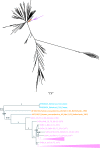Viral meningitis epidemics and a single, recent, recombinant and anthroponotic origin of swine vesicular disease virus
- PMID: 26508717
- PMCID: PMC4661520
- DOI: 10.1093/emph/eov026
Viral meningitis epidemics and a single, recent, recombinant and anthroponotic origin of swine vesicular disease virus
Abstract
Background and objectives: Swine vesicular disease virus (SVDV) is a close relative of the human Enterovirus B serotype, coxsackievirus B5. As the etiological agent of a significant emergent veterinary disease, several studies have attempted to explain its origin. However, several key questions remain, including the full biological ancestry of the virus, and its geographical and temporal origin.
Methodology: We sequenced near-complete genomes of 27 SVDV and 13 coxsackievirus B5 samples, all originally isolated between 1966 and 2006, and analysed these in conjunction with existing sequences and historical information.
Results: While analyses incorporating 24 additional near-complete SVDV genomic sequences indicate clear signs of within-SVDV recombination, all 51 SVDV isolates remain monophyletic. This supports a hypothesis of a single anthroponotic transfer origin. Analysis of individual coding and non-coding regions supports that SVDV has a recombinant origin between coxsackievirus B5 and another Enterovirus B serotype, most likely coxsackievirus A9. Extensive Bayesian sequence-based analysis of the time of the most recent common ancestor of all analysed sequences places this within a few years around 1961. Epidemiological evidence points to China as an origin, but there are no available samples to test this conclusively.
Conclusions and implications: Historical investigation and the clinical aspects of the involved Enterovirus B serotypes, makes the current results consistent with a hypothesis stating that SVDV originated through co-infection, recombination, and a single anthroponotic event, during large viral meningitis epidemics around 1960/1961 involving the ancestral serotypes. The exact geographical origin of SVDV may remain untestable due to historical aspects.
Keywords: Enterovirus B; Picornaviridae; RNA viruses; SVDV; emerging diseases; viral meningitis.
© The Author(s) 2015. Published by Oxford University Press on behalf of the Foundation for Evolution, Medicine, and Public Health.
Figures

Similar articles
-
Evolutionary histories of coxsackievirus B5 and swine vesicular disease virus reconstructed by phylodynamic and sequence variation analyses.Sci Rep. 2018 Jun 11;8(1):8821. doi: 10.1038/s41598-018-27254-y. Sci Rep. 2018. PMID: 29891869 Free PMC article.
-
Differential diagnosis and genetic analysis of the antigenically related swine vesicular disease virus and coxsackie viruses.J Virol Methods. 1995 Jun;53(2-3):189-99. doi: 10.1016/0166-0934(95)00014-l. J Virol Methods. 1995. PMID: 7673387
-
Complete nucleotide sequence of a coxsackie B5 virus and its relationship to swine vesicular disease virus.J Gen Virol. 1993 May;74 ( Pt 5):845-53. doi: 10.1099/0022-1317-74-5-845. J Gen Virol. 1993. PMID: 8388019
-
Near-complete genome sequencing of swine vesicular disease virus using the Roche GS FLX sequencing platform.PLoS One. 2014 May 9;9(5):e97180. doi: 10.1371/journal.pone.0097180. eCollection 2014. PLoS One. 2014. PMID: 24816564 Free PMC article.
-
Crystal structure of Swine vesicular disease virus and implications for host adaptation.J Virol. 2003 May;77(9):5475-86. doi: 10.1128/jvi.77.9.5475-5486.2003. J Virol. 2003. PMID: 12692248 Free PMC article.
Cited by
-
A general and biomedical perspective of viral quasispecies.RNA. 2025 Feb 19;31(3):429-443. doi: 10.1261/rna.080280.124. RNA. 2025. PMID: 39689947 Free PMC article. Review.
-
A systematic review of evidence that enteroviruses may be zoonotic.Emerg Microbes Infect. 2018 Sep 26;7(1):164. doi: 10.1038/s41426-018-0159-1. Emerg Microbes Infect. 2018. PMID: 30258048 Free PMC article.
-
Molecular characterization of two novel echovirus 18 recombinants associated with hand-foot-mouth disease.Sci Rep. 2017 Aug 16;7(1):8448. doi: 10.1038/s41598-017-09038-y. Sci Rep. 2017. PMID: 28814774 Free PMC article.
-
An outbreak of severe infections among Australian infants caused by a novel recombinant strain of human parechovirus type 3.Sci Rep. 2017 Mar 14;7:44423. doi: 10.1038/srep44423. Sci Rep. 2017. PMID: 28290509 Free PMC article.
-
Evolutionary histories of coxsackievirus B5 and swine vesicular disease virus reconstructed by phylodynamic and sequence variation analyses.Sci Rep. 2018 Jun 11;8(1):8821. doi: 10.1038/s41598-018-27254-y. Sci Rep. 2018. PMID: 29891869 Free PMC article.
References
-
- Nardelli L, Lodetti E, Gualandi GL. et al. A foot and mouth disease syndrome in pigs caused by an enterovirus. Nature 1968;219:1275–6. - PubMed
-
- Mowat GN, Darbyshire JH, Huntley JF. Differentiation of a vesicular disease of pigs in Hong Kong from foot-and-mouth disease. Vet Rec 1972;90:618–21. - PubMed
-
- Lin F, Kitching RP. Swine vesicular disease: An overview. Vet J 2000;160:192–201. - PubMed
-
- Brown F, Talbot P, Burrows R. Antigenic differences between isolates of swine vesicular disease virus and their relationship to Coxsackie B5 virus. Nature 1973;245:315–6. - PubMed
LinkOut - more resources
Full Text Sources
Other Literature Sources
Research Materials

